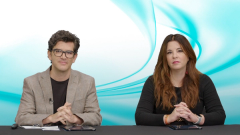
Navigating CAR-T Therapy in RRMM: Patient Counsel and Managing AEs
Explore the critical aspects of counseling patients on the expectations and management of cytokine release syndrome (CRS) and immune effector cell-associated neurotoxicity syndrome (ICANS) associated with CAR-T therapy.
Episodes in this series

Transcript:
Sagar Lonial, MD, FACP: So, let’s talk a little bit, because we skipped over some of the adverse events with CAR Ts. We may have touched on a little bit with bispecifics, but they’re a little bit worse with CAR T than they are with a bispecific, but the magnitude may be different, but it’s the same ones. How do you counsel a patient when you’re gonna give them a CAR T in terms of what to expect for CRS and ICANS?
Luciano Costa, MD: I usually tell a patient that you’re most likely to have CRS and that we’re gonna need the intervention. I mean, I think with cilta-cel [ciltacabtagene autoleucel]. it’s 97%. And there will be a very unlikely, single-digit percentage they will need ICU [intensive care unit] care, which will be the grade 3 or higher. But I emphasize that more than with the bispecifics, and of course, the neurotoxicity here is a bit more real. The rates are higher and there are some cases with grade 3 or higher. I think nowadays we feel more confident telling people that we got a good handle on that.
I think it’s extremely rare to have permanent disability from ICANS. I think the part that is more concerning is the known ICANS neurotoxicity that can be life altering…the symptoms and so forth. And I think the patients read about it and sometimes they’re concerned. I think that’s one thing that often scares patients away from CAR T.
Cesar Rodriguez, MD: True, definitely CAR T has more CRS and more neurotoxicity. And things to distinguish between BCMA bispecifics and CAR T, and even between CAR Ts, is the onset of CRS. So, with ide-cel, we tend to see CRS by the next day. With cilta-cel, we see CRS more around day 5. And unlike with bispecifics, we do want to give tocilizumab for CRS, but we want to hold off on giving the dexamethasone because we don’t want to destroy the CAR T itself. So that’s a little difference in terms of how we manage the CRS.
We will only use dexamethasone to manage CRS if the tocilizumab has not worked and anakinra has not worked. We will use it as a last resort or if it’s very severe. Neurotoxicity is definitely something that we’re having to assess more closely when it comes to CAR T. And keep in mind that tocilizumab is not going to treat neurotoxicity in ICANS. So, using anakinra and using dexamethasone in those cases is more important because the tocilizumab does not penetrate into the brain.
And then monitoring them closely and continuing their treatment with anakinra and dexamethasone until the ICANS resolves and the ICE [Immune Effector Cell Encephalopathy] score is back to 910. And yes, some patients are afraid of it. And we are seeing, for example, with cilta-cel, some toxicities that are unique to that particular CAR T. And hopefully, with time, we’re going to learn how to identify who might be at risk of developing those symptoms to try to prevent it or to try to give them an alternative therapy.
Transcript is AI-generated and edited for readability.
Newsletter
Stay up to date on recent advances in the multidisciplinary approach to cancer.






![“[This approval] will be a quite dramatic change in our philosophy and practice in multiple myeloma," according to Joseph Mikhael, MD, MEd, FRCPC, FACP, FASCO.](https://cdn.sanity.io/images/0vv8moc6/cancernetwork/3cab3ada4c023b68c118240a512e31d72a7f931b-1200x628.png?w=350&fit=crop&auto=format)

















































































